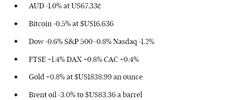bigdog
Retired many years ago
- Joined
- 19 July 2006
- Posts
- 8,215
- Reactions
- 5,655

Wall Street loses ground, marking 2nd straight weekly loss
Stocks ended lower on Wall Street as worries grow that the Federal Reserve and other central banks are willing to bring on a recession if that’s what it takes to get inflation under control.
Wall Street loses ground, marking 2nd straight weekly loss
By DAMIAN J. TROISE and ALEX VEIGAWall Street racked up more losses Friday, as worries mounted that the Federal Reserve and other central banks are willing to bring on a recession if that’s what it takes to crush inflation.
The S&P 500 fell 1.1%, its third straight drop. The Dow Jones Industrial Average dropped 0.8% and the Nasdaq composite lost 1%. The major indexes marked their second straight weekly loss.
The pullback was broad. More than 80% of stocks in the benchmark S&P 500 fell. Technology and health care stocks were among the biggest weights on the market. Microsoft fell 1.7% and Pfizer slid 4.1%.
The Fed this week raised its forecast for how high it will ultimately take interest rates and tried to dash some investors’ hopes that rate cuts may happen next year. In Europe, the central bank came off as even more aggressive in many investors’ eyes.
“Inflation continues to be the monster in the room,” said Liz Young, head of investment strategy at SoFi.
Inflation has been easing from its hottest levels in decades, but remains painfully high. That has prompted the Fed to maintain its aggressive attack on prices by raising interest rates to slow economic growth. The strategy increasingly risks slamming on the brakes too hard and sending an already slowing economy into a recession
“Whether it’s a mild, medium, or deep recession is still unknown,” Young said.
A mixed report from S&P Global on Friday highlighted the recession risk. It showed that business activity slowed more than expected this month as inflation squeezes companies. It also noted that it was the sharpest drop since May of 2020, but that inflation pressures have also been easing.
“In short, the survey data suggest that Fed rate hikes are having the desired effect on inflation, but that the economic cost is building and recession risks are consequently mounting,” Chris Williamson, chief business economist at S&P Global Market Intelligence, said.
The S&P 500 fell 43.39 points to 3,852.36. It’s now down about 19% this year. The Dow dropped 281.76 points to finish at 32,920.46. The Nasdaq slid 105.11 points to 10,705.41.
Small company stocks had more moderate losses than the broader market. The Russell 2000 fell 11.19 points, or 0.6%, to 1,763.42.
Bond yields were mixed. The yield on the 10-year Treasury, which influences mortgage rates, rose to 3.49% from 3.45% late Thursday. The yield on the two-year Treasury, which closely tracks expectations for Fed moves, fell to 4.21% from 4.24% late Thursday.
The Fed on Wednesday ended its final meeting of the year by raising its short-term interest rate by half a percentage point, its seventh straight increase this year. Wall Street had been hoping that the central bank would signal an easing of rate increases heading into 2023, but the Fed instead signaled the opposite.
The federal funds rate stands at a range of 4.25% to 4.5%, the highest level in 15 years. Fed policymakers forecast that the central bank’s rate will reach a range of 5% to 5.25% by the end of 2023. Their forecast doesn’t call for a rate cut before 2024
Several companies bucked the broader losses on Friday after reporting strong financial results and forecasts. Software maker Adobe rose 3% after topping Wall Street’s fiscal fourth-quarter earnings forecasts. United States Steel gained 5.8% after giving investors a strong earnings forecast.
















